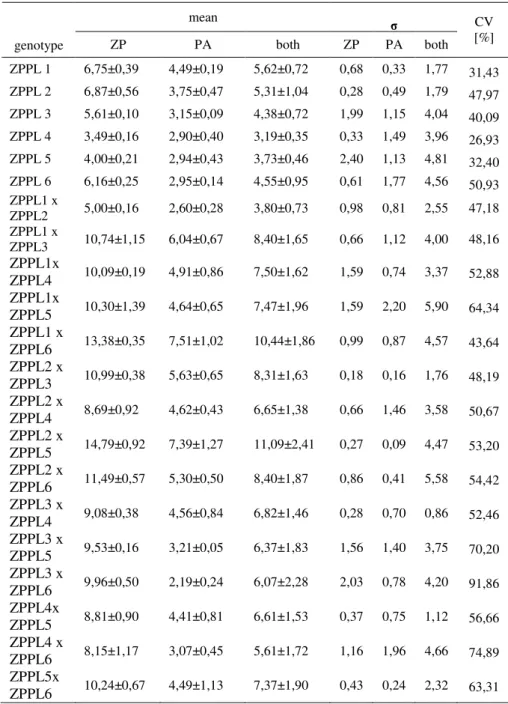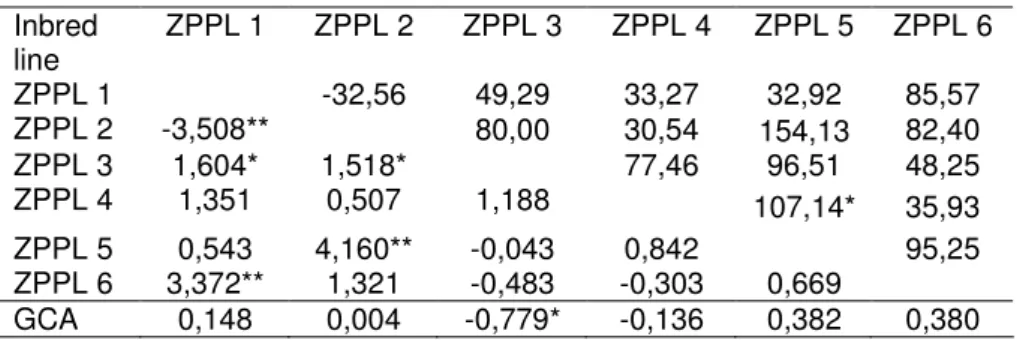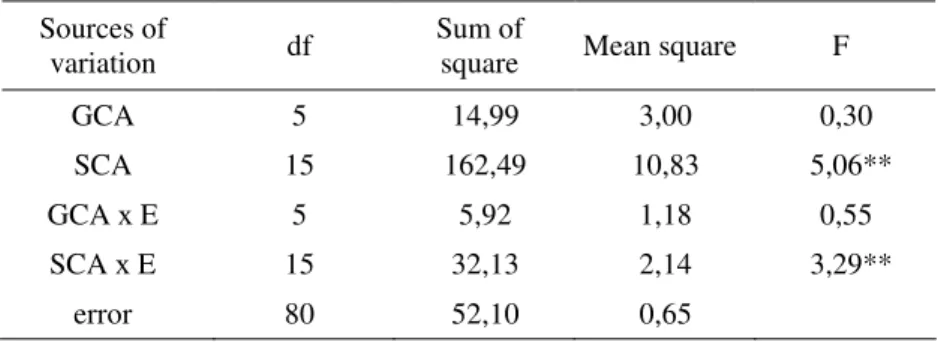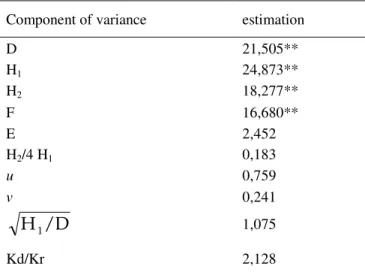______________________________
Corresponding author: Zorica Pajić, Maize Research Institute “Zemun Polje” ,
Slobodana Bajica 1, 11080 Zemun-Belgrade Serbia , E-mail: zpajic@mrizp.co.yu UDC 575:633.15 DOI:10.2298/GENSR0803249P
Original scientific paper
POPPING VOLUME AND GRAIN YIELD IN DIALLEL SET OF POPCORN INBRED LINES
Zorica PAJIĆ, Uroš ERIĆ, Jelena SRDIĆ, Snežana MLADENOVIĆ DRINIĆ
and Milomir FILIPOVIĆ
Maize Research Institute “Zemun Polje”, Belgrade, Serbia
Pajić Z., U.Erić, J.Srdić, S. Mladenović Drinić and M. Filipović
(2008): Popping volume and grain yield in diallel set of popcorn inbred lines– Genetika, Vol. 40, No. 3, 249 - 260.
Popping volume and yield are traits caused by several heredity factors. It is difficult to obtain superior genotypes for both traits but it is possible to develop genotypes with good popping volume and satisfactory yield. The hybrid ZPPL2 x ZPPL5 was superior in yield, heterosis and SCA for both yield and popping volume. As inbred ZPPL4 in all combinations has a good value for popping volume could be concluded that this inbred may be used as parent in further crosses.
Analysis of variance of the combining ability indicating significant SCA effect for grain yield, and significant both GCA and SCA effects for popping volume. Therefore it can be stated that yield is influenced by aditive and popping volume by both additive and non-additive gene effects. Analysis of variance of genetic components for popping volume indicates that the additive as well as dominant components significantly affected the inheritance of this trait in popcorn. The objective of this study was to evalute heteorsis and combing ability for grain yield and popping volume in dialalel set of six maize inbred lines.
INTRODUCTION
Grain yield and popping volume are the most important parameters of popcorn quality. Therefore, the aspiration of any breeder of this type of maize is to develop a hybrid with both high yield and popping volume. Generally, popcorn germplasm has a narrow genetic basis. Due to the higer yield and popping volume, new popcorn hybrids have almost completly replaced local varieties. SAKIN et al., (2005) compared yield and some quality characteristics of single-cross and three-way cross genotypes and open pollinated cultivars. They found significant differences among genotypes for yield, popping volume, and percentage of unpopped kernels. Popping volume was significantly higher in hybrid genotypes than open-pollinated cultivars whereas the percentage of unpopped kernels was 50% lower in hybrids. Popcorn is not only limited in germplasm quantity, but also is generally inferior to dent maize in yield and other agronomic traits (DOFINGet al., 1991; ZEIGLER and ASHMAN 1994). The most important factor affecting yield in popcorn is genotype (PAJIC 1990; PAJIC and BABIC 1991). Dent/flint germplasm could be introduced to improve grain yield and yield components through backcrossing with popcorn germplasm but due to negative correlation between popping characteristics and yield traits traditional breeding is not an efficient method to improve grain yield while maintaining popping characteristics. Higher popping volume were recorded for low- or medium-yielding cultivars whereas high-yielding cultivars had lower popping volume (PAJIC 1990).
RANGEL et al. (2008) evaulated 15 hybrids, resulting from circulant diallel of 10 parents, for grain yield and popping expansion. They concluded that intrapopulation breeding for poping expansion may offer superior genetic gains, but for grain yield, interpopulation breeding is required. VIANA and MATTA (2003) evaluated diallel crosses among five popcorn varieties to select parents for an intra and interpopulation breeding and determine two open-pollinated cultivars with highest potential as parents. Three popcorn inbred lines were evaluated as possible sources of favorable alleles for grain yield and popping volume improvement of an elite pop corn hybrid (BABICet al., 1996). The results obtained on utilization of the best enhancer of grain yield show serious reduction of popping volume and therefore the improvement should be done using the donor ranked the second for grain yield and the first for the popping volume.
MATERIAL AND METHOD
Six popcorn inbred lines (Table 1) were crossed to generate diallel set of progenies without reciprocal. Parent inbred lines and F1 crosses were arranged in a randomized block design with three replicates at two locations (Zemun Polje and Pančevo). The elementary plot size was 3,5 m2 with 57100 plants⁄ ha. The plot
consisted of two 5 m long rows, 0,7 m apart. The experiment had two additional surrounding border rows.
The traits evaluated were grain yield and popping expansion. GRIFING’S method II, model I (1956), was used for the determination of combining abilities. The analysis of components of variance and heritability was done according to MATHER and JINKS (1971). Heterosis for investigated traits was estimated on the basis of the better parent, and its significance by the t-test (STEEL and TORRIE, 1960). Popping expansion (cc/g-1) was measured according to Official Volume Test methods with metric weight volume tester (MWVT) instrument.
Table 1. Popcorn inbred lines and their sources Inbreeds Source population
ZPPL 1 ZP Syn I pc (C3) ZPPL 2 ZP Syn II pc (C2)
ZPPL 3 (South American X Ohio Yellow) X South American ZPPL 4 South American germplasm
ZPPL 5 South American germplasm ZPPL 6 Supergold x Amber Pearl
RESULTS AND DISCUSSION
F1 hybrids has statistically significant higher grain yield than inbred parents, except in case of ZPPL1 X ZPPL2 which has lower yield than parents in both location. Hybrids averaged 7,39 t/ha, with grain yields ranging from 3,80 (ZPPL1 X ZPPL2) to 11,09 t/ha (ZPPL2 X ZPPL5). Inbred parents averaged 4,46t/ha and ranged from 3,19 t/ha (ZPPL4) to 5,62 t/ha (ZPPL1), (table 2). All genotypes has higer grain yield in Zemun Polje than in Pancevo.
The analysis of variance for yield showed highly significant differences among genotypes, enviroments and genotype x enviroment interaction (table 3).
The highest heterosis for yield was detected in the combination ZPPL2 x ZPPL5 (154,13%). The lowest and negative heterosis was determined in the combination ZPPL1 x ZPPL3 (table 4). That is in accordance with results of BABIC (1993), who obtained negative heterosis for similar inbred line combinations. In an evaluation of hybrids derived from complete diallel crosses among nine parents for the trait grain yield, SCAPIM et al. (2002) found heterotic effect in 25 of 36 possible combinations indicating that the parents that have been used in diallel cross systems belong to distinct gene pools.
The GCA estimates were no significant for grain yield and the SCA estimates were significant for five out of 15 combinations (table 4). ZPPL3 has the lowest GCA but combination of that inbred with ZPPL1 and ZPPL2 has significant SCA value. SCA estimates exceeding GCA estimates, which are in accordance with results of PEREIRA and ARMAL (2001), and FREITASet al. (2006). The hybrid ZPPL2 x ZPPL5 was superior in yield, heterosis and SCA.
Table 2. Mean value, standard deviation and coefficient of variation for grain yield
mean
σ
genotype ZP PA both ZP PA both
CV [%] ZPPL 1 6,75±0,39 4,49±0,19 5,62±0,72 0,68 0,33 1,77 31,43 ZPPL 2 6,87±0,56 3,75±0,47 5,31±1,04 0,28 0,49 1,79 47,97 ZPPL 3 5,61±0,10 3,15±0,09 4,38±0,72 1,99 1,15 4,04 40,09 ZPPL 4 3,49±0,16 2,90±0,40 3,19±0,35 0,33 1,49 3,96 26,93 ZPPL 5 4,00±0,21 2,94±0,43 3,73±0,46 2,40 1,13 4,81 32,40 ZPPL 6 6,16±0,25 2,95±0,14 4,55±0,95 0,61 1,77 4,56 50,93 ZPPL1 x ZPPL2 5,00±0,16 2,60±0,28 3,80±0,73 0,98 0,81 2,55 47,18 ZPPL1 x ZPPL3 10,74±1,15 6,04±0,67 8,40±1,65 0,66 1,12 4,00 48,16 ZPPL1x ZPPL4 10,09±0,19 4,91±0,86 7,50±1,62 1,59 0,74 3,37 52,88 ZPPL1x ZPPL5 10,30±1,39 4,64±0,65 7,47±1,96 1,59 2,20 5,90 64,34 ZPPL1 x ZPPL6 13,38±0,35 7,51±1,02 10,44±1,86 0,99 0,87 4,57 43,64 ZPPL2 x ZPPL3 10,99±0,38 5,63±0,65 8,31±1,63 0,18 0,16 1,76 48,19 ZPPL2 x ZPPL4 8,69±0,92 4,62±0,43 6,65±1,38 0,66 1,46 3,58 50,67 ZPPL2 x ZPPL5 14,79±0,92 7,39±1,27 11,09±2,41 0,27 0,09 4,47 53,20 ZPPL2 x ZPPL6 11,49±0,57 5,30±0,50 8,40±1,87 0,86 0,41 5,58 54,42 ZPPL3 x ZPPL4 9,08±0,38 4,56±0,84 6,82±1,46 0,28 0,70 0,86 52,46 ZPPL3 x ZPPL5 9,53±0,16 3,21±0,05 6,37±1,83 1,56 1,40 3,75 70,20 ZPPL3 x ZPPL6 9,96±0,50 2,19±0,24 6,07±2,28 2,03 0,78 4,20 91,86 ZPPL4x ZPPL5 8,81±0,90 4,41±0,81 6,61±1,53 0,37 0,75 1,12 56,66 ZPPL4 x ZPPL6 8,15±1,17 3,07±0,45 5,61±1,72 1,16 1,96 4,66 74,89 ZPPL5x ZPPL6 10,24±0,67 4,49±1,13 7,37±1,90 0,43 0,24 2,32 63,31
Table 3. Analysis of variance for grain yield
Sources of variation df Sum of square Mean square F
enviroment 1 622,76 622,76 435,36**
replication 4 5,722 1,43 0,73
genotype 20 532,46 26,62 13,62**
G х E 20 114,14 26,62 2,92**
error 80 156,31 5,71
significant at the 0,01 probability level
Table 4. Heterosis for grain yields above diagonal, SCA values below diagonal and GCA values at bottom line.
Inbred line ZPPL 1 ZPPL 2 ZPPL 3 ZPPL 4 ZPPL 5 ZPPL 6 ZPPL 1 -32,56 49,29 33,27 32,92 85,57 ZPPL 2 -3,508** 80,00 30,54 154,13 82,40 ZPPL 3 1,604* 1,518* 77,46 96,51 48,25 ZPPL 4 1,351 0,507 1,188 107,14* 35,93 ZPPL 5 0,543 4,160** -0,043 0,842 95,25 ZPPL 6 3,372** 1,321 -0,483 -0,303 0,669 GCA 0,148 0,004 -0,779* -0,136 0,382 0,380
Analysis of variance of the combining ability (table 5), indicating significant SCA effect and SCA x enviroment interaction. These results show that hybrid combination behavior is differentiated by enviroment and highlight importance of non-aditive genetic effects. With respect to grain yield, ANDRADEet al. (2002), SCAPIMet al. (2002), PEREIRA and AMARAL JÚNIOR (2001), SIMONet al. (2004), and MIRANDA et al. (2008) also demonstrated the greater importance of non-additive effects.
Table 5. Analysis of variance of combining abilities for grain yield
Sources of
variation df Sum of square Mean square F
GCA 5 14,99 3,00 0,30 SCA 15 162,49 10,83 5,06** GCA х E 5 5,92 1,18 0,55 SCA х E 15 32,13 2,14 3,29** error 80 52,10 0,65 GCA/SCA=0,059
Popping volume - Popping volume is one of the most important quality
traits in popcorn. Popping volume for the six-entry diallel averaged 30,99 сс/g-1
for parents and 34,47 сс/g-1 for the hybrids, (table 6). All genotypes have higher
value for popping volume in Zemun Polje. According to LYERLY (1942) crosses of high popping volume inbreeds tended to have high popping volumes, whereas hybrids between low popping volumes inbreeds tended to have low popping volumes. In our study the highest popping volume has combinations between two inbreeds with high popping volume value ZPPL4 x ZPPL6. However, combination of one inbred with high popping volume value ZPPL4 and inbred ZPPL2, with low, also has very high popping volume value. As inbred ZPPL4 in all combinations has a good value for popping volume could be concluded that this inbred may be used as parent in further crosses.
The coefficient of variation for popping volume and grain yield were 15,48% and 47,97%, respectively. Similar studies of popcorn cultivars carried out by SCAPIM et al. (2002), ANDRADE et al., (2002) and CARPENTIERI-PIPOLO et al. (2003) obtained high CV values for these traits.
The analysis of variance for popping volume showed highly significant differences among genotypes, environments and genotype x environment interaction (table 7). Genotypes x environment interaction were significant for grain yield and popping volume. This suggests that genotypes with broad adaptation or specific adaptability to the each of the environments are needed for optimization of yield and popping volume.
Table 6. Mean value, standard deviation and coefficient of variation for popping volume mean σ genotype ZP PA both ZP PA both CV [%] ZPPL 1 36,89±0,63 30,22±0,04 33,56±1,98 1,10 0,08 4,84 14,43 ZPPL 2 24,49±0,35 20,67±0,14 22,58±1,13 0,60 0,24 2,78 12,30 ZPPL 3 36,83±0,44 31,94±0,12 34,39±1,45 0,76 0,20 3,55 10,31 ZPPL 4 41,00±0,69 32,67±0,47 36,84±2,48 1,19 0,82 6,06 16,46 ZPPL 5 29,95±0,51 27,72±0,09 28,83±0,74 0,88 0,16 1,81 6,27 ZPPL 6 36,78±0,25 33,67±0,27 35,22±0,94 0,44 0,47 2,29 6,51 ZPPL1 X ZPPL2 32,17±1,03 27,33±0,00 29,75±1,57 1,78 0,00 3,86 12,96 ZPPL1 X ZPPL3 40,11±0,09 30,78±0,47 35,44±2,72 0,16 0,82 6,65 18,77 ZPPL1X ZPPL4 39,61±0,69 32,05±0,70 35,83±2,29 1,19 1,22 5,61 15,65 ZPPL1X ZPPL5 36,00±0,83 28,89±0,63 32,44±2,18 1,44 1,10 5,35 16,48 ZPPL1 X ZPPL6 29,34±0,68 19,61±0,32 24,47±2,86 1,18 0,55 7,00 28,60 ZPPL2 X ZPPL3 40,66±0,14 30,77±0,59 35,72±2,89 0,24 1,03 7,07 19,80 ZPPL2 X ZPPL4 40,05±0,30 38,89±0,20 39,47±0,42 0,52 0,34 1,03 2,61 ZPPL2 X ZPPL5 35,33±0,42 29,83±0,21 32,58±1,62 0,72 0,36 3,97 12,19 ZPPL2 X ZPPL6 37,28±0,33 33,94±0,28 35,61±1,01 0,57 0,48 2,47 6,94 ZPPL3 X ZPPL4 39,00±0,24 33,16±0,96 36,08±1,82 0,41 1,66 4,47 12,38 ZPPL3 X ZPPL5 36,94±0,05 28,33±0,63 32,64±2,53 0,08 1,09 6,19 18,95 ZPPL3 X ZPPL6 40,89±0,32 31,56±0,24 36,22±2,71 0,55 0,42 6,64 18,32 ZPPL4X ZPPL5 38,22±0,32 34,44±0,24 36,33±1,13 0,55 0,42 2,76 7,59 ZPPL4 X ZPPL6 41,61±0,24 37,78±0,55 39,70±1,19 0,42 0,96 2,91 7,32 ZPPL5X ZPPL6 37,28±0,16 32,33±0,57 34,81±1,49 0,28 0,98 3,65 10,47 all genotypes 36,67±0,55 30,79±0,57 33,74±1,57 4,38 4,54 5,22 15,48
Table 7. Analysis of variance for popping volume
Sources of
variation df Sum of square Mean square F
enviroment 1 1095,60 1095,60 1068,04**
replication 4 4.10 1,03 1,06
genotype 20 2216,70 110,84 114,62**
G х E 20 208,16 10,41 10,76**
error 80 77,36 0,97
Better parent heterosis for popping expansion ranged from −30,52% (ZPPL1 x ZPPL6) to 13,01% (ZPPL2 x ZPPL5). Popping expansion of high-yielding combination ZPPL1xZPPL6 was poor at less than of both parent lines. For popping volume no significance heterosis was found in F1 crosses, which is in accordance with results of ANDRADE et al (2002). Eight out of 15 F1 hybrid combinations had negative heterosis as indicated that choice of parent which would have positive heterosis for popping volume, but in same time have a good all another agronomic trait would not be easily.
Table 8. Popping expansion heterosis above diagonal, SCA values below diagonal and GCA values at bottom line
Inbred line ZPPL 1 ZPPL 2 ZPPL 3 ZPPL 4 ZPPL 5 ZPPL 6 ZPPL 1 -11,35 3,08 -2,71 -3,31 -30,52 ZPPL 2 -0,381 3,87 7,14 13,01 1,11 ZPPL 3 2,235** 3,042** -2,18 -5,09 2,84 ZPPL 4 0,162 4,792** -2,386** -1,52 -1,52 ZPPL 5 1,528** 2,230** -0,656 0,535 -1,24 ZPPL 6 -8,608** 3,521** 0,722 2,553** 1,390** 35,22 GCA -1,344** -2,253** 1,063** 3,093** -1,162** 0,601**
The GCA estimates were significant for popping volume and the SCA estimates were significant for ten out of 15 combinations (table 8). Combination of two inbred lines, ZPPL4 and ZPPL2, one with the highest and another with the lowest GCA, had the highest SCA value and the highest popping expansion ability. LARISH and BREWBAKER (1999) identified significant GCA and SCA effects for popping expansion in the two popcorn diallel evaluated in the USA. The GCA estimates were significant for popping expansion and the sign of the estimate indicates whether the line in question is superior (+) or inferior (-) to the others. Popping expansion can be increased by the use of inbred lines ZPPL4 and
ZPPL3. FRIETAS JUNIOR et al. (2006) obtained combining ability of ten popcorn cultivars in a circulant partial diallel crossing and conclude that additive effects were more important than non-additive effects only for popping expansion. The predominance of genetic additive effects in popcorn for popping expansion had also been described by PEREIRA and AMARAL JÚNIOR (2001), SIMONet al. (2004), and MIRANDAet al., 2008.
Analysis of variance of genetic components for popping volume (table 9) indicated that the additive component (D), as well as dominant components (H1 and H2) significantly affected the inheritance of popping volume in popcorn. The positive estimation of F indicated that the number of dominant alleles in the expression of popping volume was higer than the number of recesive alleles in parent involved in the diallel cross. This was confirmed by the frequency of dominant (0,759) and recessive alleles (0,241). Therefore, dominant and recessive alleles were not equally present in the parents. The ratio H2/4 H1 (0,183)was lower than 0,25 as well as ratio Kd/Kr was higer than 1. The mean degree of dominance in the inheritance of popping volume was slighty higer than 1 and points to the presence of weak superdominance in the inheritance of popping volume. The obtained results are in accordinance with results obtained by BABIC (1994), who reported superdominance in the inheritance of popping volume.
Table 9.Components of variance for popping volume.
Component of variance estimation
D 21,505** H1 24,873** H2 18,277** F 16,680** E 2,452 H2/4 H1 0,183 u 0,759 v 0,241
/D
Η
1 1,075 Kd/Kr 2,128** − significant at 0,01 probability level
A midle heritability in a narrow sense (0,44), but high heritability in a border sense (0,807) was expressed for popping volume. According to ZEIGLER
(2000) heritability estimates for popping expansion have ranged from 0,62 to 0,96. This also, points to a high share of dominant variance.
ACKNOWLEDGMENT
This research was supported by the Ministry of Science and Technology, Republic of Serbia, through Project TR20003.
Received October 3rd 2008 Accepted November 10th, 2008
REFERENCES
ANDRADE,, R.A., C.D. CRUZ, C.A. SCAPIM, L SILVÉRIO, RJB PINTO., and A.TONET (2002): Análise dialélica da capacidade combinatória de variedades de milho pipoca. Acta Scientiarum 24: 1197-1204.
BABIĆ, M. (1993): Nasleđivawe prinosa zrna, zapremine kokičavosti i morfoloških osobina kukuruza kokičara., magistarski rad, Univerzitet u Novom Sadu.
BABIĆ, M. and Z. PAJIĆ (1994): Inheritance of popping volume in popcorn hybrids (Zea mays L. everta). - Genetika, Vol. 26, No. 1, 21-30.
BABIĆ, M., Z. PAJIĆ, N. DELIĆ, and G. TODOROVIĆ (1996): Identification of donors containing favourable alleles for grain yield and popping volume in pop com (Zea mays L. everta). - Genetika. Vol. 28, No. 1, 17-22
CARPENTIERI-PIPOLO, V., FAM. SILVA, AD.SEIFERT (2003): Popcorn parental selection based on genetic divergence.Crop Breed Appl Biotechnol 3, 261-268.
DOFING, S.M., N..D’CROZ-MASON, M.A. THOMAS-COMPTON (1991): Inheritance of expansion volume
and yield in two popcorn × dent corn crosses. Crop Sci 31:715.718
FREITAS JÚNIOR,, S.P., A.T. AMARAL JÚNIOR, M.G, PEREIRA, C.D. CRUZ, and C.A. SCAPIM (2006):
Capacidade combinatória em milho pipoca por meio de dialelo circulante. Pesquisa Agropecuária Brasileira 41: 1599-1607.
GRIFFING, B. (1956): Concept of general and specific combining ability in relation to diallel crossing sistems. Austr. J. Biol. Sci., East Melbourne, n.9, p.463-493.
LARISH, L.L.B., and J.L .BREWBAKER (1999): Diallel analyses of temperate and tropical popcorns. Maydica, Bergamo, n.44, p. 279-284.
LYERLY, P.J. (1942): Some genetic and morphological characters affecting the popping expansion of popcorn. Journal of the American Society of Agronomy 34: 986-995.
MATHER, K. amd J.JINKS (1971): Biometrical genetics. 2nd edition, Chapman and Hall, London.
MIRANDA, G.V., L.V. SOUZA, J.C.C. GALVÃO, L.J.M. GUIMARÃES (2008): Genetic variability and heterotic groups of Brazilian popcorn populations. Euphytica 159: 123-132.
PAJIC, Z. (1990): Popcorn and sweet corn breeding. International Advanced Course Maize Breeding, Production, Processing and Marketing in Mediterranean Countries MAIZE’90. September 17 to October 13, 1990, Belgrade, Yugoslavia.
PAJIC, Z., M.BABIC (1991): Interrelation of popping volume and some agronomic characteristics in popcorn hybrids. Genetika 23, 137-144.
PEREIRA, M.G. and A.T. AMARAL JÚNIOR (2001): Estimation of genetic components in popcorn based on the nested design. Crop Breeding and Applied Biotechnology 1: 3-10.
RANGEL, R.M., A.T. AMARAL JÚNIOR, C.A. SCAPIM, S.P. FREITAS JÚNIOR and M.G. PEREIRA (2008):
Genetic parameters in parents and hybrids of circulant diallel in popcorn Genetics and Molecular Research 7 (4): 1020-1030.
SAKIN, A.M., S.GOKMEN, A.YILDIRIM, S.BELEN, N.. KANDEMIR (2005):Effects of cultivar type on yield
and quality of popcorn (Zea mays everta). New Zealand Journal of Crop and Horticultural Science, Vol. 33: 17–23.
SCAPIM, C.A., C.A.P. PACHECO, A. TONET , A.L. BRACCINI, and R.J.B. PINTO (2002): Análise dialélica e heterose de populações de milho pipoca. Bragantia 61: 219-230.
SIMON, G.A., C.A. SCAPIM, C.A.P. PACHECO, R.J.B. PINTO, A.L.BRACCINI and A.TONET (2004). Depressão por endogamia em populações de milho pipoca. Bragantia 63: 55-62.
STEEL R.G. and J.H.TORRIE (1960): Principes and procedures of statistics. Mc Graw Hill Book. VIANA, J.M.S. and F.P. MATTA (2003): Analysis of general and specific combining abilities of popcorn
populations, including selfed parents. Genetics and Molecular Biology, 26, 4, 465-471. ZIEGLER, KE, and B.ASHMAN (1994): Popcorn. In: Hallauer AR (ed) Specialty Corns. CRC Press, New
York, pp 189–223
ZIEGLER, K.E. (2000): Popcorn in Specialty Corns, Second Edition Edited by Arnel R Hallauer ,CRC Press
ZAPREMINA KOKIČAVOSTI I PRINOS ZRNA U DIALELNOM SETU LINIJA KOKIČARA
Zorica PAJIĆ, Uroš ERIĆ, Jelena SRDIĆ, Snežana MLADENOVIĆ DRINIĆ
i Milomir FILIPOVIĆ
Institut za kukuruz “Zemun Polje”, Beograd, Srbija I z v o d
Zapremina kokičavosti i prinos su svojstva pod uticajem nekoliko
naslednih faktora. Teško je dobiti superiorne genotipove za oba svojstva ali je moguće dobiti genotip sa dobrom zapreminom kokičavosti i zadovoljavajućim
prinosom. Hibrid ZPPL2 x ZPPL5 je superioran za prinos, heterozis i PKS za prinos i zapreminu kokičavosti. Kako linija ZPPL4 u svim kombinacijama ima
dobre vrednosti za zapreminu kokičavosti može se zaključiti da ova linija se može
koristiti kao roditelj u budućim ukrštanjima.
Analiza varijanse za kombinacionu sposobnost ukazuje na značajan PKS
efekat za prinos zrna, značajan PKS i OKS efekat za zapreminu kokičavosti.
Prinos je pod uticajem neaditivnih a zapremina kokičavosti i aditivnih i neaditivnih
gena. Analiza varijanse genetičkih komponenti za zapreminu kokičavosti ukazuje
da aditivne kao i dominatne komponente značajno utiču na nasleđivanje ovog
svojstva kod kokičara.
Cilj ovih istraživanja bio je ispitivanje heteorzisa i kombinacionih sposobnosti za prinos zrna i zapreminu kokičavosti u dialelnom setu šest linija
kukuruza.
Primljeno 03. X. 2008. Odobreno 10. XI. 2008.



![Table 6. Mean value, standard deviation and coefficient of variation for popping volume mean σ genotype ZP PA both ZP PA both CV [%] ZPPL 1 36,89±0,63 30,22±0,04 33,56±1,98 1,10 0,08 4,84 14,43 ZPPL 2 24,49±0,35 20,67±0,14 22,58±1,](https://thumb-ap.123doks.com/thumbv2/123dok/1650982.2588683/7.892.245.752.190.883/table-standard-deviation-coefficient-variation-popping-volume-genotype.webp)

